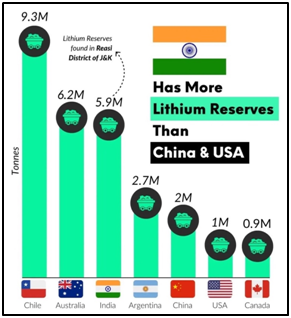Why in News?
- India is on the brink of securing a significant deal for five lithium blocks in Argentina, with negotiations reportedly in the final stages.
- This strategic move could be a game-changer in reducing India's reliance on China for critical minerals.
What’s in Today’s Article?
- About Lithium (Properties, Applications, Availability, Top Producers, etc.)
- News Summary
About Lithium:
- Lithium is a chemical element with the symbol Li and atomic number 3. It is a soft, silvery-white alkali metal.
- Lithium is a special metal in many ways. It's light and soft — it can be cut with a kitchen knife and so low in density that it floats on water.
Applications of Lithium:
- The most important use of lithium is in rechargeable batteries for mobile phones, laptops, digital cameras and electric vehicles (EVs).
- Lithium is often dubbed as “white gold” for electric vehicles.
- Lithium metal is made into alloys with aluminium and magnesium, improving their strength and making them lighter.
- Aluminium-lithium alloys are used in aircraft, bicycle frames and high-speed trains.
- Lithium has no known biological role. It is toxic, except in very small doses.
Where is Lithium Found Naturally?

- Lithium makes up a mere 0.0007 per cent of the Earth's crust and it's only found locked up in minerals and salts.
- With 9.3 million tonnes, Chile has the world’s largest known lithium reserves.
- Chile is followed by Australia (6.2 million tonnes).
- In 2023, the Geological Survey of India, found that 9 million tonnes have been found in Salal-Haimana area of Reasi district of J&K.
- India now has the third largest resource of lithium globally, but it will take time to convert it to reserves.
- India is followed by Argentina (2.7 million tonnes) and China (2 million tonnes).
- Global lithium production surpassed 100,000 tonnes for the first time in 2021, quadrupling from 2010. Currently, Australia alone produces 52% of the world’s lithium.
Future of Lithium Production:
- As the world produces more batteries and EVs, the demand for lithium is projected to reach 1.5 million tonnes of lithium carbonate equivalent (LCE) by 2025 and over 3 million tonnes by 2030.
- Based on the above demand projections, production needs to triple by 2025 and increase nearly six-fold by 2030.
News Summary:
- The Union Ministry of Mines, through the state-owned Khanij Bidesh India Ltd (KABIL), has entered into a draft exploration and development agreement with Argentinean miner CAMYEN.
- This agreement is for possible acquisition and development of five-odd lithium blocks.
- The company has also entered into a non-disclosure agreement with Chilean miner ENAMI for “possible exploration, extraction, processing and commercialisation” of the mineral.
- It has also appointed consultancy major PwC for identification of investable projects in Australia.
Acquisitions in Argentina:
- India has over the last one year upped its search for critical mineral, especially lithium.
- Lithium is a cornerstone in India’s switch to green energy thereby reducing its carbon footprints.
- Argentina, with its enormous lithium deposits and low production costs, is ideally positioned to supply this demand.
- As of September 2023, Argentina has two active lithium mines. There are 14 lithium projects under construction or in the advanced exploration stage in Argentina.
- Argentina is expected to become one of the world’s leading lithium producers once these projects become operational.
- The KABIL board had approved the ‘Draft Exploration and Development Agreement” earlier and a proposal for opening of Branch Office in Catamarca, Argentina was subsequently cleared by the Ministry.









